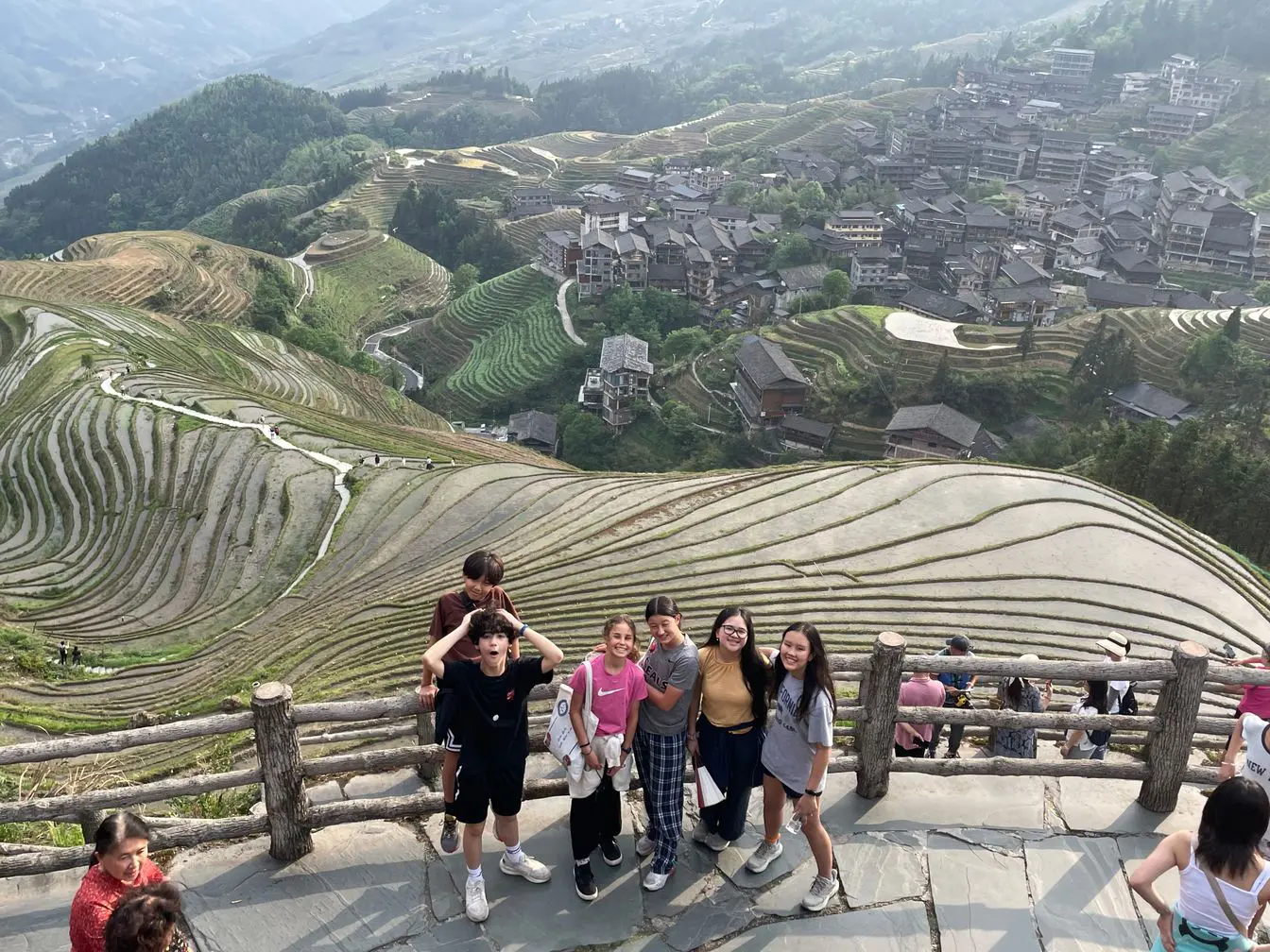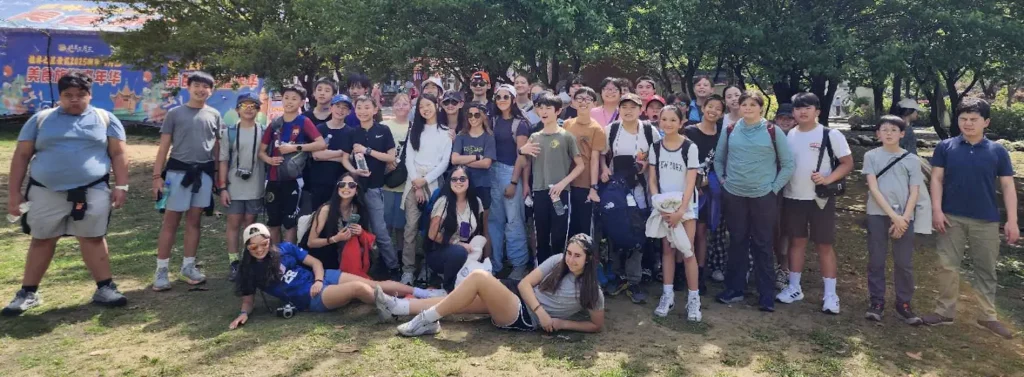
The 7th Grade program itinerary is built in close collaboration with The Chinese Language Institute (CLI), our program operator in Guilin. CAIS students are placed in a host family in Guilin, with a host sibling from a local school.
Daily Dispatches from Guilin Trip Chaperones

April 8, 2025: Tea and Taiji. We began our journey by immersing ourselves in the rich and intricate world of Chinese tea culture. Our first lesson was in tea leaf picking—learning to identify high-quality leaves and carefully place them into traditional bamboo baskets. Surrounded by vast rows of lush tea bushes, the experience felt both serene and enchanting. Observing the tea master roast the leaves was like watching an art form unfold. With practiced skill, he taught us how to stir the leaves in a heated wok, releasing a warm, earthy aroma that filled the air and evoked a sense of comfort and tradition. Later, we participated in a tea-tasting session, sampling three distinct varieties: black tea, green tea, and oolong tea. Each offered a unique flavor profile and cultural significance. Students also discovered an interesting custom: when someone pours tea for you, it is customary to express gratitude by gently tapping the table three times with the first two fingers—a subtle yet meaningful gesture of appreciation.
As if that wasn’t enough, we even got to try Tai Chi. Our teacher explained where it comes from and taught us a few basic moves. It was peaceful, slow, and graceful.
April 9, 2025: Scavenger Hunt. Students went to Shan Lake in the city center for a treasure hunt adventure! Two grand ancient structures stand right in the middle of the lake, looking mysterious and majestic. They are called: The Sun and Moon Twin Pagodas. They are iconic landmarks in Guilin, with rich symbolism and deep cultural meaning. The “Sun Pagoda” and the “Moon Pagoda” represent the concepts of Yin and Yang, a core philosophy in Chinese culture. The relationship between the two pagodas embodies the balance and unity of opposites, reflecting the harmony found in nature. As we followed the treasure hunt clues, we discovered all kinds of signs, figures, and interesting objects along the way, including 桂A license plates, rabbit heads, and Chinglish Style T-Shirt, etc. Only one team could emerge victorious, Mr. Fettinger’s Goofy Goobers, but the highlight of the day for all? Finding tanghulu—those delicious candied hawthorns on a stick!

April 10, 2025: A Day of Culture and Curiosity – We began the day at 祝圣寺 (Zhùshèng Sì), a peaceful Buddhist temple nestled in the hills. As we walked through the temple grounds, the scent of incense filled the air and soft chanting echoed around us. Students were fascinated by the colorful statues, ancient carvings, and the calm, reflective atmosphere. We tried to be quiet so we could leave everything just as peaceful as they were. Later, We sat in a circle, learned about the temple’s history, and discussed why it holds deep meaning for so many people. We also explored the world of Traditional Chinese Medicine. Students saw shelves full of dried herbs, roots, and mysterious ingredients. A local doctor explained how herbal remedies help the body heal and rebalance. Wide eyes and curious questions followed—like, “Is that a dried seahorse?” and “How does this help a headache?” We finished the day at the fruit market, where students picked out fresh local fruits and ate them with big smiles.
April 11, 2025: Cultural Exchange at Guidian Middle School – This day was all about connection. We visited Guidian Middle School, where our students were paired with local 7th graders for activities. Everyone was a bit shy at first, but soon the room buzzed with laughter and conversation as students played games, created art, and talked about school life in both countries.
We arrived on campus with a warm welcome from the principal and a delightful performance by kindergarten students drumming for us. Their cuteness made us all go “Aw…!” The Guidian students also showcased traditional Chinese dance, painting, and kung fu, and we even joined in on the kung fu moves! Later, we participated in PE activities where students formed teams to tackle fun challenges. The “wooden ski shoes” race was especially tricky—we weren’t sure if we were falling from the difficulty or from laughing too hard!
April 12 & 13, 2025: Weekend with Homestay Families – Back at CLI, students spent their first full weekend with their homestay families with fun activities, such as hiking in Xiangpi Shan, Minecraft Movie, Fishing, Barbeque, etc. We also heard many stories like…
- “I think my family gave me too much food… but it was so good! I even got fried chicken. It was heaven!”
- “The highlight of the day was hanging out with all the siblings, it was not the most exciting, but it was the best!”
- “I have been learning so much about Chinese cooking with my host mom! I am enjoying great food!”
- “OMG, I’ve been hearing so much Chinese, I thought my brain was going to explode—but now I’m getting used to it, and I understand more!”
- “I talked to my host brother for hours this weekend. I think I’m starting to sound like a Chinese middle schooler!”
- “I lost my tooth and threw it on the roof! Do you know why? It’s part of Chinese culture!”
April 14, 2025: Nature and Adventure in Seven Stars Park – We spent the day at Seven Star Park, a beautiful space known for its limestone formations, lush bamboo, and hidden caves. We hiked under the trees, spotted monkeys (don’t make eye contact or show your teeth!), and soaked in the songs of the birds.
During a quiet rest under the trees, we reflected and drew maps of our footsteps—that is how we capture the memories we’re making together.

April 15, 2025: Ludi Yan (Reed Flute Cave): We began our trip, led by two local guides. We walked through the cave and listened to many stories about the stunning stalactites, stalagmites, and rock formations illuminated with colorful lights. Can you believe this cave is 1,200 years old? No wonder Money King and his little monkeys lived here. Many fun landscapes resemble animals and fruit. Our favorite one was the Dragon Pagoda, which stands in the middle of the pond, looking mysterious yet powerful.
April 16, 2025: Flying Tiger Museum: As we entered the museum, we were struck by all the U.S. Army symbols—it felt like a scene straight out of Top Gun: Maverick! With help from our guide, we learned how the museum honors the friendship between China and the United States during World War II. Highlights included General Claire Chennault’s command cave, historic photos, military artifacts, and a C-47 transport aircraft donated by the Flying Tiger Historical Organization. To end the day, we played fun games with local college students—an energetic and joyful finish to a meaningful visit.
April 17, 2025: Day Trip to Xing Ping Gu Zhen and Watch Qian Gu Qing: Today was packed with excitement! Our bus ride turned into a karaoke party, with students belting out everything from Taylor Swift to Bruno Mars—pop, country, you name it! At Xingping Ancient Town, we explored unique shops and bought souvenirs. Some students picked up osmanthus gel, a popular gift since osmanthus is Guilin’s signature scent. We also spotted items we recognized from Kung Fu Panda and Ne Zha! Bargaining in Chinese was a fun challenge, and with help from our local teachers, many of us scored great deals.
Later, we watched Qian Gu Qing, a spectacular live musical. It explored themes of “落叶归根” (fallen leaves returning to their roots), “home is where the heart is,” and love. The special effects were jaw-dropping—“Look at those people running on the wall!” “There are rice noodles on the ceiling!”—and we couldn’t stop talking about it on the ride home.
April 18, 2025: Farewell Dinner with Homestay Families: We had an unforgettable farewell dinner with our homestay families, and the whole evening felt like a dream! The venue was beautifully decorated with soft blue flowers and elegant ceiling decorations that made the place feel so magical. We couldn’t stop taking pictures because everywhere we looked was just so pretty. One of the highlights of the night was when we got to perform on stage. At first, there wasn’t enough space for all of us, but one of our classmates showed great leadership and helped solve the problem, making sure everyone could be part of the show. In the end, the performance was a blast, and we were so proud of each other! The evening also gave us the chance to say a proper goodbye to our homestay families. It was a warm and touching moment, and we felt so thankful for all the love and care they had given us during our stay.

April 21, 2025: Dragon’s Backbone Rice Terraces -《龙脊梯田》
层层叠叠绕青山,Layer upon layer, the hills embrace,
云雾缭绕绘画间。Mist and cloud weave nature’s grace.
水镜天光翻稻浪,Mirror-like waters reflect the skies,
四时更替换新颜。The seasons shift, and beauty thrives.
This morning, our students bid farewell to their homestay families, carrying with them a bittersweet sense of gratitude and affection. It was a privilege to have been cared for by such kind hosts across the ocean — from the thoughtful bags of gifts and washed and packed fruits, to the quiet tears exchanged at parting. Upon our arrival in Longji, one of the students turned to us and asked, “May I call my homestay mom?” One of our chaperones, moved by the sincerity of the moment, replied gently, “Of course.” Although the weather forecast had predicted rain, 天公作美 — the skies were kind, and the day remained clear. We spent the afternoon walking through the breathtaking Longji Rice Terraces, where the fields unfold like giant steps carved into the mountains. Layer upon layer, they curve gracefully along the hillsides, forming an elegant, flowing landscape. Our local guide, dressed in traditional attire, introduced us to the wild strawberries, fresh cabbages, and tadpoles that thrive along the path. It was a walk filled with simple joy; we lifted our arms wide, welcomed the moment, and breathed in the crisp, refreshing air of the mountains.
April 22, 2025: Oil Tea and Bamboo – Following the scent of tea, we arrived at the home of one of our local guides. It was a traditional Zhuang minority house, steeped in history, the kind of place where the walls seem to tell stories. We called our host “A Sao,” a respectful way to address a married woman, like saying “sister-in-law.” If a woman is unmarried, we would say “A Jie,” meaning “sister.” A Jie sat quietly in her chair, holding a few sticks of firewood. She placed them into the small fire pit at the center of the room, then set a steel wok over the flames. First, she added oil, followed by garlic, ginger, and tea leaves. As she worked, we practiced saying the names of each ingredient in Chinese, trying hard to memorize everything she showed us. Soon, the oil tea was ready. Steam rose from the wok, curling into the air—it was the perfect comfort on a rainy day. We weren’t sure if we’d like the taste, and nervously whispered to our teacher, “Laoshi, how can we be polite if we don’t like it?” But after just one sip, someone exclaimed, “Hm… so good!” A Jie smiled gently in response.
When the rain began to let up, we stepped out onto the rice terraces again. This time, we were in search of bamboo shoots. A Jie explained that this season only produces the hairy variety—there are three other kinds in Longji that grow during different times of the year. She cut a few shoots for us to smell. The scent was earthy and fresh—so good. No wonder pandas love them so much!
Later that evening, after dinner, we gathered around the campfire and danced hand in hand with the local villagers—clapping, laughing, and leaping between bamboo poles. Oh, what a magical night. Voices echoed through the air: “That was so fun!”
April 23, 2025: Appliqué Embroidery – During our travels, we often found ourselves admiring the clothing of the Zhuang people—especially the intricate patterns along the bottoms of their pants and the edges of their sleeves. Though traditional, their clothing sits confidently at the forefront of fashion, blending history with style. Today, we had the chance to try it ourselves, getting hands-on with a beautiful tradition from the Zhuang minority: appliqué embroidery. It wasn’t just an art project—it was a deep dive into a cultural practice filled with color, meaning, and incredible craftsmanship. When we arrived, everything was ready for us—swatches of fabric in reds, blues, greens, and yellows, along with needles, colorful threads, and fabric scissors. The room buzzed with curiosity as we gathered around the examples: butterflies, birds, and swirling geometric designs, all carefully stitched onto fabric squares. Our instructor introduced the tradition and explained how Zhuang women have passed down this embroidery style for generations. It’s more than decoration—it’s storytelling through thread. Every shape and color has a meaning. Butterflies, for example, symbolize love and transformation. But we have to admit—this is hard work! It probably takes more time and patience than we imagined to finish even one piece.
Today also marks our last day in Longji. After one final hour on the road, we returned to Guilin, preparing for our journey home to San Francisco.
